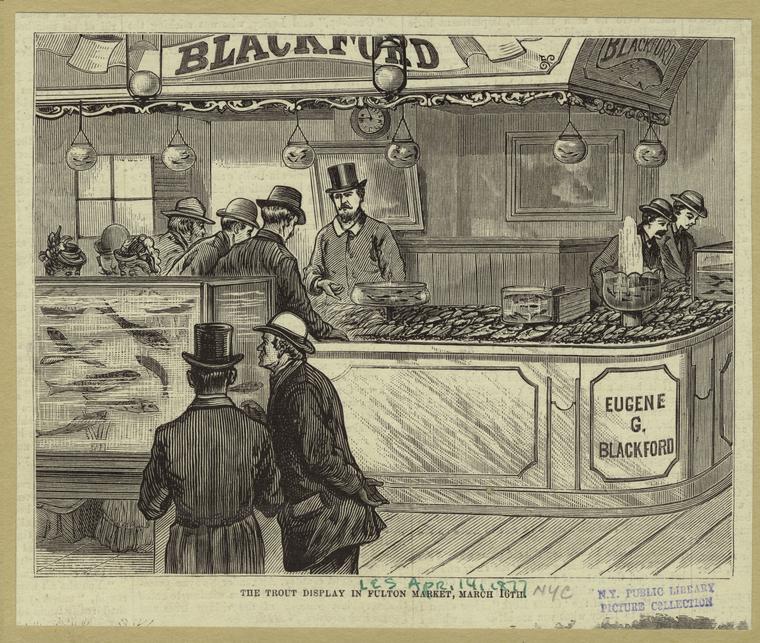Blog Archive
Tails and Scales: The Fate of the Fulton Fish Market Hangs in the Balance
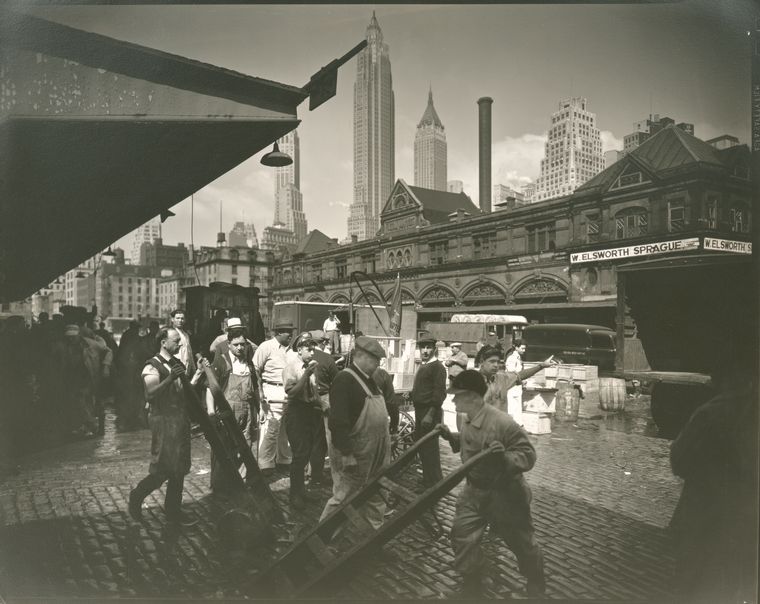
The Fulton Fish Market fully-functioning and close to the height of its powers in Manhattan in 1936. Photo courtesy of the New York Public Library.
Long gone are the days when New York City was a just a market town. At one time, our proud metropolis was just a small seaport with six municipal markets. New Yorkers who hear the word “market” today are more likely to think of Wall Street’s Stock Exchange than a gathering of food vendors. The larger markets that do exist in the city- the Chelsea Market and the Gansevoort Market – feature specialty purveyors rather than the raucous fishmongers in sturdy rubber waders. One man, Robert LaValva, hopes to change all that by bringing a market back to the former space of Manhattan’s Fulton Fish Market. How did such a vital market end up needing to be rescued? The history of this Market is the perfect example of food consumption in New York.
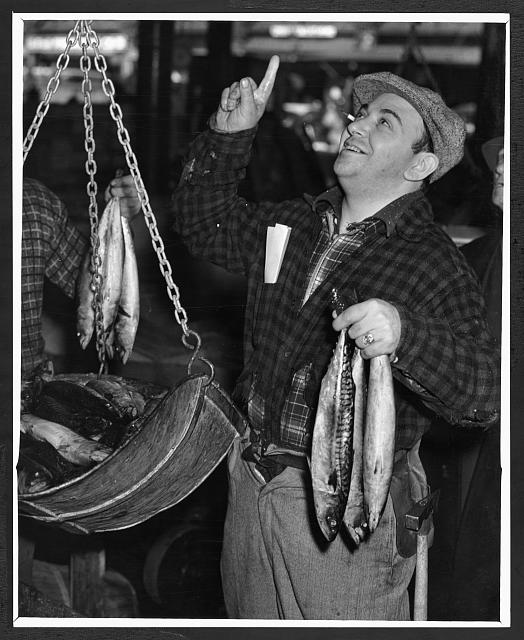
Caught by net, sold by pound. Buck Steo weighs a fresh load of mackerel at Fulton Fish Market in 1935. World Telegram & Sun photo by F. Palumbo. Photo courtesy of the Library of Congress.
Once a vibrant and necessary element of Manhattan, the Fish Market eventually gained a reputation for being a somewhat neglected mismanagement of real estate too valuable to remain undeveloped. The current battle for the former Fish Market Space is between the Howard Hughes Corporation – seeking to turn the space in to a site for luxury real estate – and Robert LaValva. Mr. LaValva hopes to restore a major market to that area like those which can be found in major European capitals, such the London Borough Market and the renown Mercado de La Boqueria in Barcelona, and in the U.S. cities, markets such as the Reading Terminal Market in Philadelphia or the West Side Market in Cleveland, Ohio.
The Fulton Fish Market was founded in 1807. The Market space was once a general supply area hosting produce stalls, butchers and fish mongers. In 1822 the Fish Market became independent from the general market moving to occupy the Fulton Fish Market building on South Street between Fulton and Beekman Street. The Fish Market before 1850 was mainly a direct supply system. Fisherman would sail into port – usually around midnight – with their catch where housekeepers and cooks would purchase the fish directly. After 1850, wholesale merchants became an intermediary between fishermen and buyers, a process more familiar to us today.
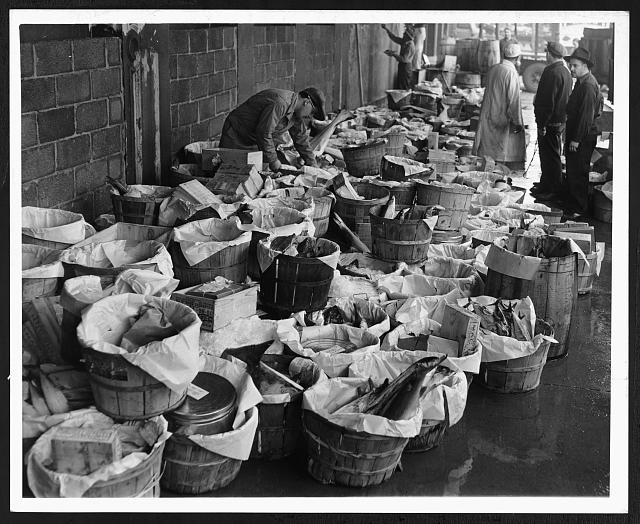
Orders being sorted for delivery or pick up in 1944. Photo credit World Telegram & Sun photo by Al Aumuller. Photo courtesy of the Library of Congress.
In 1924 the Fulton Fish Market reportedly sold 384 million pounds of fish which amounted to 25% of all the seafood sold in the United States that year. The Market consisted of two open-air structures: one called the Tin Building and the other known as the “New” Building. The New building was opened in 1939 by Mayor LaGuardia after the previous structure fell into the ocean when its wooden pilings rotted and gave way. The entirety of that first structure slipped [like a fish] in the East River. Eventually, as the Manhattan ports became less used, seafood was brought to market by truck and air.
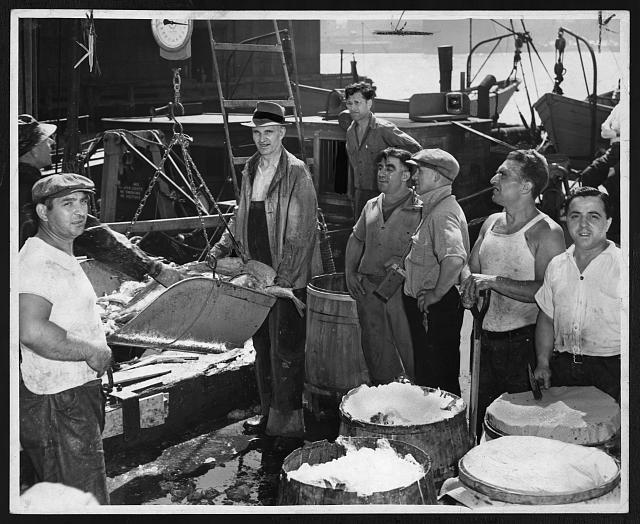
Gabbing and trading big fish stories in the open air before FDA regulations drove most of the Market indoors. Photo courtesy of the LOC.
In the mid to late 1990’s a series of reforms challenged the traditions of Fulton Market. New Federal health regulations made it illegal to sell fish in the open air, ruling that all fish should be refrigerated upon point of sale. This regulation opposed the tradition of the Fulton Market in which fish was sold on beds of ice. During the 1990’s, Mayor Guiliani also began to target what he noted as pockets of organized crime in the market by adding stricter policies regarding licensing and staff. Official records cite these as reasons for moving the market to the 30 acres of vacant space in the Bronx. Skeptics have also pointed out that the city-owned land upon which the Fulton Market once stood had become too valuable to remain host to such an modest operation as the fish Market.
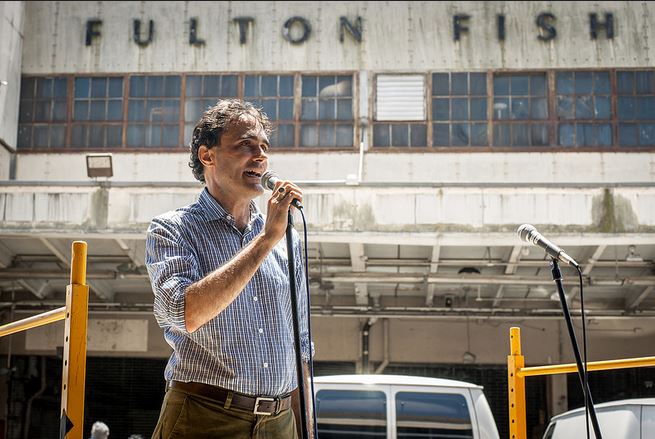
Robert LaValva addressing hopefuls at a #savefultonfishmkt event. Photo courtesy of New Amsterdam Market.
The struggle for the current space has come down to a contest between the Howard Hughes Corporation and Robert LaValva with his plans for a traditional market. Although a market is temporarily running in the Fulton Space, the Howard Hughes Corporation which took the lease for the space in 2010 is indeed hoping to develop the space for a high-rise. The Hughes Corporation plan includes construction costs up to 120 million dollars with aspirations to move the Tin building 30 feet to clear space for a 50 story hotel tower. LaValva, who put his Harvard Design School degree to use at the Department of Sanitation and with the Metropolitan Transit Authority, argues for the intrinsic rather than monetary value of a city market, saying in a recent New York Times article that “the High Line does not make a penny” but brings immense joy and vitality to its Chelsea neighborhood. He has said he wants the new market to “not just a place of business but of calling.”
–Posted by Julia Berick, Marketing and Communications Coordinator
